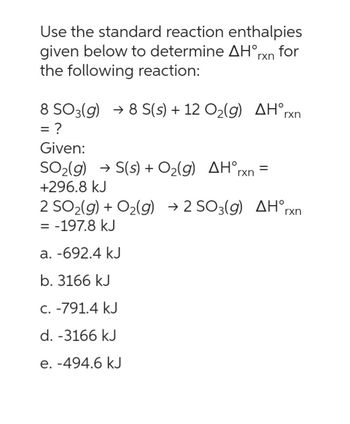
Chemistry
10th Edition
ISBN: 9781305957404
Author: Steven S. Zumdahl, Susan A. Zumdahl, Donald J. DeCoste
Publisher: Cengage Learning
expand_more
expand_more
format_list_bulleted
Question
thumb_up100%

Transcribed Image Text:Use the standard reaction enthalpies
given below to determine AH°rxn for
the following reaction:
rxn
8 SO3(g) →8 S(s) + 12 O₂(g) AHᵒr
= ?
Given:
SO₂(g) → S(s) + O₂(g) AH°rxn
+296.8 kJ
=
2 SO₂(g) + O₂(g) → 2 SO3(g) AH rxn
= -197.8 kJ
a. -692.4 kJ
b. 3166 kJ
c. -791.4 kJ
d. -3166 kJ
e. -494.6 kJ
Expert Solution
This question has been solved!
Explore an expertly crafted, step-by-step solution for a thorough understanding of key concepts.
This is a popular solution
Trending nowThis is a popular solution!
Step by stepSolved in 3 steps with 2 images

Knowledge Booster
Learn more about
Need a deep-dive on the concept behind this application? Look no further. Learn more about this topic, chemistry and related others by exploring similar questions and additional content below.Similar questions
- A chemist measures the enthalpy change AH during the following reaction: Fe(s) + 2 HCl(g)→FECL,(s) + H,(9) AH=-157, kJ Use this information to complete the table below. Round each of your answers to the nearest kJ/mol. reaction ΔΗ x10 을Fels) + 3 1 1 1 -HCI(g) FeCl, (s) + 3 (8) | kJ 3 FeCl, (6) + (8) Fe(s) + HCI(g) 6 3 FeCl, (s) + H, (g) Fe(s) + 2HC1(g)arrow_forwardDetermine the standard enthalpy of formation of Fe2O3(s) given the thermochemical equations below. Fe(s) + 3 H2O(l) → Fe(OH)3(s) + 3/2 H2(g) ΔrH° = +160.9 kJ H2(g) + 1/2 O2(g) → H2O(l) ΔrH° = –285.8 kJ Fe2O3(s) + 3 H2O(l) → 2 Fe(OH)3(s) ΔrH° = +288.6 kJarrow_forwardCalcium hydroxide is prepared by adding calcium oxide to water: CaO (s) + H2O (l) → Ca(OH)2 (s) Calculate the enthalpy change (ΔH) for this reaction considering the following experiment. A 10.0 g sample of CaO (s) {MM = 56.08 g/mol} is added to 1.00 liter of water in a calorimeter with a total heat capacity of 4.37 kJ K-1 and the temperature increases by 2.70 K.arrow_forward
- Calculate ΔH for the reaction NO(g) + O(g) → NO2(g) given the following information: NO(g) + O3(g) → NO2(g) + O2(g) ΔH = -198.9 kJ O3(g) → 3/2O2 ΔH = -142.3 kJ O2(g) → 2 O(g) ΔH = 495.0 kJarrow_forwardFind the ΔH (kJ) for the reaction below, given the following reactions and subsequent ΔH values: N2(g) + 2O2(g) → 2NO 2(g) N2(g) + 3H2(g) → 2NH3(g) ΔH = -115 kJ 2NH3(g) + 4H2O(l) → 2NO2(g) + 7H2(g) ΔH = -142.5 kJ H2O(l) → H2(g) + 1/2O 2(g) ΔH = -43.7 kJ (Supply answer up to the 1st decimal point)arrow_forwardThe standard enthalpy change for the following reaction is 103 kJ at 298 K. N2(g) + O2(g) + Cl2(g) ---------> 2 NOCl(g) ΔH° = 103 kJ What is the standard enthalpy change for this reaction at 298 K? 1/2 N2(g) + 1/2 O2(g) + 1/2 Cl2(g)--------> NOCl(g) kJarrow_forward
- Given the following thermochemical equations, 2Cu (s) + S (s) · → Cu₂S (s) AH° = -79.5 kJ S (s) + O₂ (g) → SO₂ (g) AH° = −297 kJ Cu₂ S (s) +20₂ (g) → 2CuO (s) + SO₂ (g) AH° = -527.5 kJ calculate the standard enthalpy of formation (in kJ mole¹¹) of CuO (s).arrow_forwardUse the standard reaction enthalpies given below to determine ΔH°rxn for the following reaction: (Hess Law)4 NO(g) + 2 O2(g) → 4 NO2(g)ΔH°rxn = ? Given: N2(g) + O2(g) → 2 NO(g) ΔH°rxn = +183 kJ 1/2 N2(g) + O2(g) → NO2(g) ΔH°rxn = +33 kJarrow_forwardWhat is the standard enthalpy change for the reaction? 2NH3(g)N2H4(l) + H2(g)N2H4(l) + O2(g)N2(g) + 2H2O(g) ΔH°1 = –543 kJ·mol–12H2(g) + O2(g)2H2O(g) ΔH°2 = –484 kJ·mol–1N2(g) + 3H2(g)2NH3(g) ΔH°3= –92 kJ·mol–1arrow_forward
- Given the standard enthalpy changes for the following two reactions: (1) Hg(1) + Cl,(g) →HgCl,(s) AH° = -224.3 kJ (2) Fe(s) + Cl2(g)→FeCl,(s) AH° = -341.8 kJ what is the standard enthalpy change for the reaction: (3) Hg(1) + FeCl,(s)→ →HgCl,(s) + Fe(s) ΔΗ-? kJ Submit Answer Try Another Version 3 item attempts remainingarrow_forwardUsing the equations Ca(s) + 1/2 0, (g) → CaO (s) AH° = -450 kJ/mol CO, (g) → C (s) + O, (g) AH° = 394 kJ/mol Determine the enthalpy for the reaction C(s) + 2 CaO(s) → CO, (g) + 2 Ca(s). KJ/mol 1 2 3 6. C 7 8 9. +/- х 100 4.arrow_forwardUse Hess's Law to calculate the enthalpy for this reaction: 4SO3(g) → 4S(s) + 602(g) AH° ??? kJ !! rxn Given the following thermochemical equations: SO2(g)→ S(s) + O2{g) AH° = +296.8 kJ 2SO2(g) + O2(g) → 2SO3(g) AH° = -197.8 kJarrow_forward
arrow_back_ios
SEE MORE QUESTIONS
arrow_forward_ios
Recommended textbooks for you
 ChemistryChemistryISBN:9781305957404Author:Steven S. Zumdahl, Susan A. Zumdahl, Donald J. DeCostePublisher:Cengage Learning
ChemistryChemistryISBN:9781305957404Author:Steven S. Zumdahl, Susan A. Zumdahl, Donald J. DeCostePublisher:Cengage Learning ChemistryChemistryISBN:9781259911156Author:Raymond Chang Dr., Jason Overby ProfessorPublisher:McGraw-Hill Education
ChemistryChemistryISBN:9781259911156Author:Raymond Chang Dr., Jason Overby ProfessorPublisher:McGraw-Hill Education Principles of Instrumental AnalysisChemistryISBN:9781305577213Author:Douglas A. Skoog, F. James Holler, Stanley R. CrouchPublisher:Cengage Learning
Principles of Instrumental AnalysisChemistryISBN:9781305577213Author:Douglas A. Skoog, F. James Holler, Stanley R. CrouchPublisher:Cengage Learning Organic ChemistryChemistryISBN:9780078021558Author:Janice Gorzynski Smith Dr.Publisher:McGraw-Hill Education
Organic ChemistryChemistryISBN:9780078021558Author:Janice Gorzynski Smith Dr.Publisher:McGraw-Hill Education Chemistry: Principles and ReactionsChemistryISBN:9781305079373Author:William L. Masterton, Cecile N. HurleyPublisher:Cengage Learning
Chemistry: Principles and ReactionsChemistryISBN:9781305079373Author:William L. Masterton, Cecile N. HurleyPublisher:Cengage Learning Elementary Principles of Chemical Processes, Bind...ChemistryISBN:9781118431221Author:Richard M. Felder, Ronald W. Rousseau, Lisa G. BullardPublisher:WILEY
Elementary Principles of Chemical Processes, Bind...ChemistryISBN:9781118431221Author:Richard M. Felder, Ronald W. Rousseau, Lisa G. BullardPublisher:WILEY

Chemistry
Chemistry
ISBN:9781305957404
Author:Steven S. Zumdahl, Susan A. Zumdahl, Donald J. DeCoste
Publisher:Cengage Learning

Chemistry
Chemistry
ISBN:9781259911156
Author:Raymond Chang Dr., Jason Overby Professor
Publisher:McGraw-Hill Education

Principles of Instrumental Analysis
Chemistry
ISBN:9781305577213
Author:Douglas A. Skoog, F. James Holler, Stanley R. Crouch
Publisher:Cengage Learning

Organic Chemistry
Chemistry
ISBN:9780078021558
Author:Janice Gorzynski Smith Dr.
Publisher:McGraw-Hill Education

Chemistry: Principles and Reactions
Chemistry
ISBN:9781305079373
Author:William L. Masterton, Cecile N. Hurley
Publisher:Cengage Learning

Elementary Principles of Chemical Processes, Bind...
Chemistry
ISBN:9781118431221
Author:Richard M. Felder, Ronald W. Rousseau, Lisa G. Bullard
Publisher:WILEY